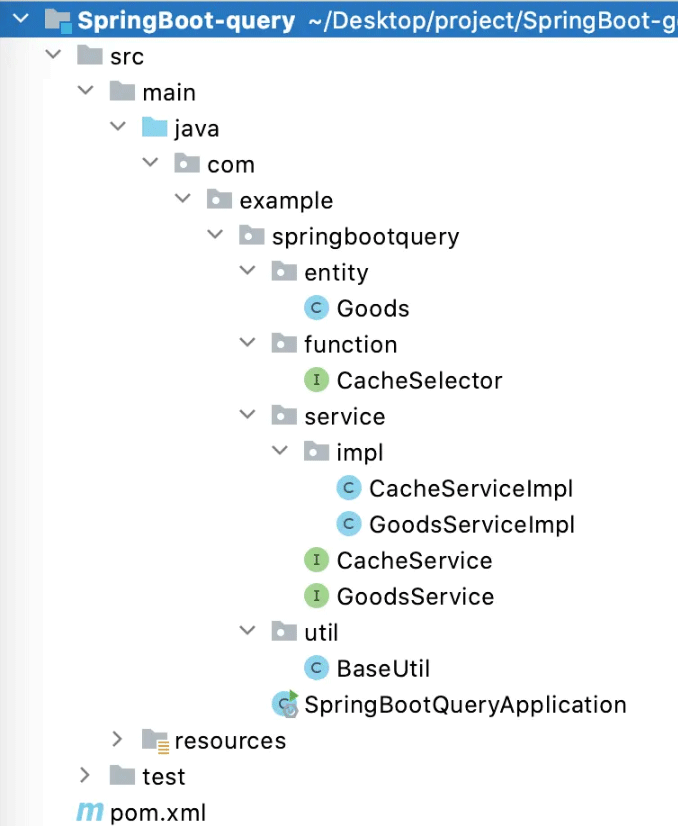使用Java实现先查询缓存再查询数据库
目录
- 前言
- 栗子
- 思路分析
- 原理介绍
- 代码实现
- 项目代码
- 配置文件
- 项目结构
- SpringBootQueryApplication.java
- Goods.java
- CacheSelector.java
- CacheService.java
- CacheServiceImpl.java
- GoodsService.java
- GoodsServiceImpl.java
- BaseUtil.java (核心类)
- 用法
- 第一次从数据中查询
- 第二次从缓存中查询
前言
在访问量大的时候,为了提高查询效率,我们会将数据先缓存到redis中。先查询redis,查询不到再去查询数据库,实现这个逻辑也不复杂,写一个if(...)else{...}也就行了。这种做法也不是不行,就是看起来有点儿粗糙,所以我想换一种更优雅的写法。
栗子
现有一个使用商品名称查询商品的需求,要求先查询缓存,查不到则去数据库查询;从数据库查询到之后加入缓存,再查询时继续先查询缓存。
思路分析
可以写一个条件判断,伪代码如下:
//先从缓存中查询
String goodsInfoStr = redis.get(goodsName);
if(StringUtils.isBlank(goodsInfoStr)){
//如果缓存中查询为空,则去数据库中查询
Goods goods = goodsMapper.queryByName(goodsName);
//将查询到的数据存入缓存
goodsName.set(goodsName,JSONObject.toJSONString(goods));
//返回商品数据
return goods;
}else{
//将查询到的str转换为对象并返回
return JSON.parseObject(goodsInfoStr, Goods.class);
}
上面这串代码也可以实现查询效果,看起来也不是很复杂,但是这串代码是不可复用的,只能用在这个场景。假设在我们的系统中还有很多类似上面商品查询的需求,那么我们需要到处写这样的if(...)else{...}。作为一个程序员,不能把类似的或者重复的代码统一起来是一件很难受的事情,所以需要对这种场景的代码进行优化。
上面这串代码的问题在于:入参不固定、返回值也不固定,如果仅仅是参数不固定,使用泛型即可。但最关键的是查询方法也是不固定的,比如查询商品和查询用户肯定不是一个查询方法吧。
所以如果我们可以把一个方法(即上面的各种查询方法)也能当做一个参数传入一个统一的判断方法就好了,类似于:
/** * 这个方法的作用是:先执行method1方法,如果method1查询或执行不成功,再执行method2方法 */ public static<T> T selectCacheByTemplate(method1,method2)
想要实现上面的这种效果,就不得不提到Java8的新特性:函数式编程
原理介绍
在Java中有一个package:java.util.function ,里面全部是接口,并且都被@FunctionalInterface注解所修饰。
Function分类
- Consumer(消费):接受参数,无返回值
- Function(函数):接受参数,有返回值
- Operator(操作):接受参数,返回与参数同类型的值
- Predicate(断言):接受参数,返回boolean类型
- Supplier(供应):无参数,有返回值
具体我就不在赘述了,可以参考:Java 函数式编程梳理
代码实现
那么接下来就来使用Java优雅的实现先查询缓存再查询数据库吧!
项目代码
配置文件
pom.xml
<?xml version="1.0" encoding="UTF-8"?>
<project xmlns="http://maven.apache.org/POM/4.0.0" xmlns:xsi="http://www.w3.org/2001/XMLSchema-instance"
xsi:schemaLocation="http://maven.apache.org/POM/4.0.0 https://maven.apache.org/xsd/maven-4.0.0.xsd">
<modelVersion>4.0.0</modelVersion>
<parent>
<groupId>org.springframework.boot</groupId>
<artifactId>spring-boot-starter-parent</artifactId>
<version>2.7.2</version>
<relativePath/> <!-- lookup parent from repository -->
</parent>
<groupId>com.example</groupId>
<artifactId>SpringBoot-query</artifactId>
<version>0.0.1-SNAPSHOT</version>
<name>SpringBoot-query</name>
<description>Demo project for Spring Boot</description>
<properties>
<java.version>1.8</java.version>
</properties>
<dependencies>
<!-- redis -->
<dependency>
<groupId>org.springframework.boot</groupId>
<artifactId>spring-boot-starter-data-redis</artifactId>
</dependency>
<!-- fastjson -->
<dependency>
<groupId>com.alibaba</groupId>
<artifactId>fastjson</artifactId>
<version>1.2.83</version>
</dependency>
<dependency>
<groupId>org.springframework.boot</groupId>
<artifactId>spring-boot-starter-web</artifactId>
</dependency>
<dependency>
<groupId>org.springframework.boot</groupId>
<artifactId>spring-boot-starter-test</artifactId>
<scope>test</scope>
</dependency>
</dependencies>
<build>
<plugins>
<plugin>
<groupId>org.springframework.boot</groupId>
<artifactId>spring-boot-maven-plugin</artifactId>
</plugin>
</plugins>
</build>
</project>
项目结构

其中CacheService是从缓存中查询数据,GoodsService是从数据库中查询数据
SpringBootQueryApplication.java
package com.example.springbootquery;
import org.springframework.boot.SpringApplication;
import org.springframework.boot.autoconfigure.SpringBootApplication;
@SpringBootApplication
public class SpringBootQueryApplication {
public static void main(String[] args) {
SpringApplication.run(SpringBootQueryApplication.class, args);
}
}
Goods.java
package com.example.springbootquery.entity;
public class Goods {
private String goodsName;
private Integer goodsTotal;
private Double price;
public String getGoodsName() {
return goodsName;
}
public void setGoodsName(String goodsName) {
this.goodsName = goodsName;
}
public Integer getGoodsTotal() {
return goodsTotal;
}
public void setGoodsTotal(Integer goodsTotal) {
this.goodsTotal = goodsTotal;
}
public Double getPrice() {
return price;
}
public void setPrice(Double price) {
this.price = price;
}
@Override
public String toString() {
return "Goods{" +
"goodsName='" + goodsName + '\'' +
", goodsTotal='" + goodsTotal + '\'' +
", price=" + price +
'}';
}
}
CacheSelector.java
自定义函数式接口:
package com.example.springbootquery.function;
@FunctionalInterface
public interface CacheSelector<T> {
T select() throws Exception;
}
CacheService.java
package com.example.springbootquery.service;
import com.example.springbootquery.entity.Goods;
public interface CacheService {
/**
* 从缓存中获取商品
*
* @param goodsName 商品名称
* @return goods
*/
Goods getGoodsByName(String goodsName) throws Exception;
}
CacheServiceImpl.java
package com.example.springbootquery.service.impl;
import com.alibaba.fastjson.JSON;
import com.example.springbootquery.entity.Goods;
import com.example.springbootquery.service.CacheService;
import org.springframework.beans.factory.annotation.Autowired;
import org.springframework.data.redis.core.StringRedisTemplate;
import org.springframework.stereotype.Service;
@Service("cacheService")
public class CacheServiceImpl implements CacheService {
@Autowired
private StringRedisTemplate redisTemplate;
@Override
public Goods getGoodsByName(String goodsName) throws Exception {
String s = redisTemplate.opsForValue().get(goodsName);
return null == s ? null : JSON.parseObject(s, Goods.class);
}
}
GoodsService.java
package com.example.springbootquery.service;
import com.example.springbootquery.entity.Goods;
public interface GoodsService {
Goods getGoodsByName(String goodsName);
}
GoodsServiceImpl.java
这里我就不连接数据库了,模拟一个返回
package com.example.springbootquery.service.impl;
import com.alibaba.fastjson.JSONObject;
import com.example.springbootquery.entity.Goods;
import com.example.springbootquery.service.GoodsService;
import org.springframework.beans.factory.annotation.Autowired;
import org.springframework.data.redis.core.StringRedisTemplate;
import org.springframework.stereotype.Service;
@Service
public class GoodsServiceImpl implements GoodsService {
@Autowired
private StringRedisTemplate stringRedisTemplate;
@Override
public Goods getGoodsByName(String goodsName) {
Goods goods = new Goods();
goods.setGoodsName("商品名1");
goods.setGoodsTotal(20);
goods.setPrice(30.0D);
stringRedisTemplate.opsForValue().set(goodsName, JSONObject.toJSONString(goods));
return goods;
}
}
BaseUtil.java (核心类)
因为我不关心参数,只需要一个返回值就行了,所以这里使用的是Supplier。
package com.example.springbootquery.util;
import com.example.springbootquery.function.CacheSelector;
import java.util.function.Supplier;
public class BaseUtil {
/**
* 缓存查询模板
*
* @param cacheSelector 查询缓存的方法
* @param databaseSelector 数据库查询方法
* @return T
*/
public static <T> T selectCacheByTemplate(CacheSelector<T> cacheSelector, Supplier<T> databaseSelector) {
try {
System.out.println("query data from redis ······");
// 先查 Redis缓存
T t = cacheSelector.select();
if (t == null) {
// 没有记录再查询数据库
System.err.println("redis 中没有查询到");
System.out.println("query data from database ······");
return databaseSelector.get();
} else {
return t;
}
} catch (Exception e) {
// 缓存查询出错,则去数据库查询
e.printStackTrace();
System.err.println("redis 查询出错");
System.out.println("query data from database ······");
return databaseSelector.get();
}
}
}
用法
package com.example.springbootquery;
import com.example.springbootquery.entity.Goods;
import com.example.springbootquery.service.CacheService;
import com.example.springbootquery.service.GoodsService;
import org.junit.jupiter.api.Test;
import org.springframework.beans.factory.annotation.Autowired;
import org.springframework.boot.test.context.SpringBootTest;
import static com.example.springbootquery.util.BaseUtil.selectCacheByTemplate;
@SpringBootTest
class SpringBootQueryApplicationTests {
@Autowired
private CacheService cacheService;
@Autowired
private GoodsService userService;
@Test
void contextLoads() throws Exception {
Goods user = selectCacheByTemplate(
() -> cacheService.getGoodsByName("商品名1"),
() -> userService.getGoodsByName("商品名1")
);
System.out.println(user);
}
}
第一次从数据中查询

第二次从缓存中查询

到此这篇关于使用Java实现先查询缓存再查询数据库的文章就介绍到这了,更多相关ava查询内容请搜索我们以前的文章或继续浏览下面的相关文章希望大家以后多多支持我们!

